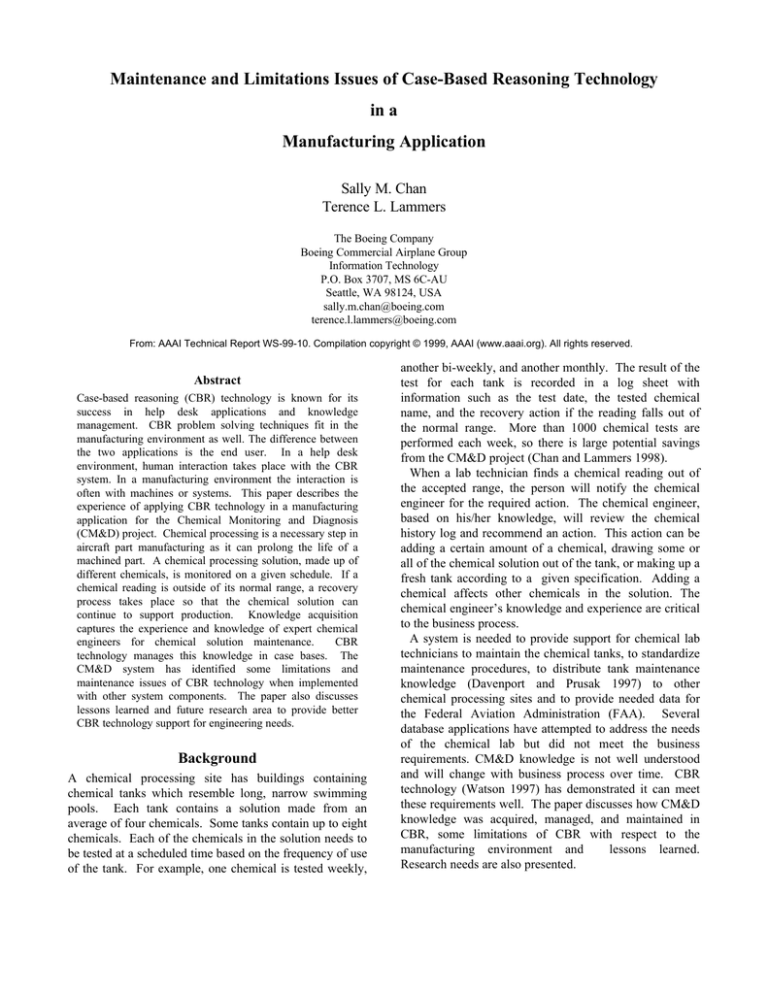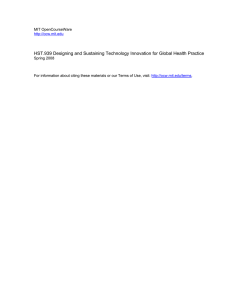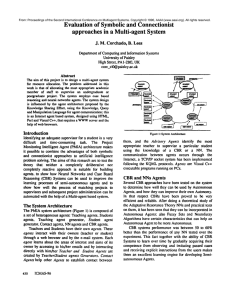
Maintenance and Limitations Issues of Case-Based Reasoning Technology
in a
Manufacturing Application
Sally M. Chan
Terence L. Lammers
The Boeing Company
Boeing Commercial Airplane Group
Information Technology
P.O. Box 3707, MS 6C-AU
Seattle, WA 98124, USA
sally.m.chan@boeing.com
terence.l.lammers@boeing.com
From: AAAI Technical Report WS-99-10. Compilation copyright © 1999, AAAI (www.aaai.org). All rights reserved.
Abstract
Case-based reasoning (CBR) technology is known for its
success in help desk applications and knowledge
management. CBR problem solving techniques fit in the
manufacturing environment as well. The difference between
the two applications is the end user. In a help desk
environment, human interaction takes place with the CBR
system. In a manufacturing environment the interaction is
often with machines or systems. This paper describes the
experience of applying CBR technology in a manufacturing
application for the Chemical Monitoring and Diagnosis
(CM&D) project. Chemical processing is a necessary step in
aircraft part manufacturing as it can prolong the life of a
machined part. A chemical processing solution, made up of
different chemicals, is monitored on a given schedule. If a
chemical reading is outside of its normal range, a recovery
process takes place so that the chemical solution can
continue to support production. Knowledge acquisition
captures the experience and knowledge of expert chemical
engineers for chemical solution maintenance.
CBR
technology manages this knowledge in case bases. The
CM&D system has identified some limitations and
maintenance issues of CBR technology when implemented
with other system components. The paper also discusses
lessons learned and future research area to provide better
CBR technology support for engineering needs.
Background
A chemical processing site has buildings containing
chemical tanks which resemble long, narrow swimming
pools. Each tank contains a solution made from an
average of four chemicals. Some tanks contain up to eight
chemicals. Each of the chemicals in the solution needs to
be tested at a scheduled time based on the frequency of use
of the tank. For example, one chemical is tested weekly,
another bi-weekly, and another monthly. The result of the
test for each tank is recorded in a log sheet with
information such as the test date, the tested chemical
name, and the recovery action if the reading falls out of
the normal range. More than 1000 chemical tests are
performed each week, so there is large potential savings
from the CM&D project (Chan and Lammers 1998).
When a lab technician finds a chemical reading out of
the accepted range, the person will notify the chemical
engineer for the required action. The chemical engineer,
based on his/her knowledge, will review the chemical
history log and recommend an action. This action can be
adding a certain amount of a chemical, drawing some or
all of the chemical solution out of the tank, or making up a
fresh tank according to a given specification. Adding a
chemical affects other chemicals in the solution. The
chemical engineer’s knowledge and experience are critical
to the business process.
A system is needed to provide support for chemical lab
technicians to maintain the chemical tanks, to standardize
maintenance procedures, to distribute tank maintenance
knowledge (Davenport and Prusak 1997) to other
chemical processing sites and to provide needed data for
the Federal Aviation Administration (FAA). Several
database applications have attempted to address the needs
of the chemical lab but did not meet the business
requirements. CM&D knowledge is not well understood
and will change with business process over time. CBR
technology (Watson 1997) has demonstrated it can meet
these requirements well. The paper discusses how CM&D
knowledge was acquired, managed, and maintained in
CBR, some limitations of CBR with respect to the
manufacturing environment and
lessons learned.
Research needs are also presented.
the question and action cycle in the system. Each of the
chemicals was discussed in detail. Because the chemical
engineers document their data in log books, each entry of
a particular chemical was reviewed carefully to determine
a standard recommendation. A lot of the data reviewed
did not fall into a consistent pattern. In this case the
chemist needed to look through the history and
recommend an action on a trial basis. Even an
experienced chemist sometimes hesitates to suggest a
specific recommendation even if promised it would be
very easy to change. There was a misconception that what
showed on the computer screen was the same as the
external environment. A conservative action was always
preferred. The chemist interviewed also admitted that it
was difficult to write maintenance rules even though the
process had been done many times in the past from
experience.
The next 10 minutes wrapped up the tank discussion.
The remaining 20 minutes was a document review or case
based system demo of the information gathered from the
previous session. Table 1 and 2 show examples of cases
developed in CBR tool from the knowledge gathered from
the chemist for a tank. The document review and system
demonstration brought out some changes to the
maintenance rules and sometimes additional system
requirements such as the need for the FAA to audit the
chemical history data, and the need to generate required
forms for the business process.
The knowledge in Table 1 was implemented in this way.
If case 24 succeeded, the case called for an action of
adding 55 gals HNO3 and 15 gals of HF. The CM&D
Knowledge Acquisition
Knowledge acquisition (Tansley and Hayball 1993) took
place at the manufacturing site with the chemical
engineers. There are three areas of tank maintenance
where knowledge acquisition is required: chemical tanks,
rinse tanks, and the make-up of new tanks. Rinse tanks
contain water. A machined part going through more than
one chemical process requires a rinse in between.
Knowledge acquisition meetings were scheduled at least
once a week, if time allowed two consecutive meetings
took place. Each meeting was about 2-1/2 hours long.
The discussion started from general characteristic of the
tank to the specifics of each chemical in the tank solution.
These meetings helped the developer understand the
business process of the chemical lab so a system can be
designed to automate their work process as well as
manage the critical knowledge required by the business.
The average time to acquire the information needed for a
single tank was two weeks or 3 to 4 meeting sessions. In
the first meeting, the first 30 minutes were spent on
general information about the tank. It is important to let
the user talk freely with little questioning from the CBR
developer. The information collected here was often what
the expert thinks is important; it is information one needs
to consider, even though it may not be needed by the
system.
The next 1-1/2 hours were concentrated on the specifics
of chemical solution maintenance. It is helpful for the
interviewer to act as a CBR tool and see the interviewee as
the end user. This helps to establish the requirements in
Case 24
Question:
Answer:
Please enter the ID of the chemical tank.
What test do you like to perform?
What is the reading of HNO3?
What is the reading of Etch Rate?
Aub-M8
HNO3
58 to 68
2 to 3
Action:
1) Add 55 gals HNO3 and 15 gals of HF.
Table 1: A sample case showing “Add” maintenance action
application would generate an Add form which contained
tank information and chemical add information. The
chemist would review the information; he/she could
override the recommendation. If the add amount was
approved, the Add form information would be stored into
the database and a physical form would be sent to the
shop. After the shop completed the chemical add, the
shop technician would fill in the actual adds on the Add
form with the completion data and remark. The database
and the case base would be updated. If case 25, shown in
Table 2, succeeded the system would generate a Disposal
form. Business process was similar for both forms.
Case 25
Question:
Answer:
Please enter the ID of the chemical tank.
What test do you like to perform?
What is the reading of HNO3?
What is the reading of Ti?
What is the reading of Etch Rate?
Aub-M8
HNO3
69 to 85
Normal
4.8 to 5
Action:
1) Check temperature.
2) Check HNO3 concentration, consider adding HF.
•
If the chemical level is high, check the chemical analysis log and either:
•
Dump a portion of the tank contents
•
Dump all of the tank contents
Table 2: A sample case showing “Disposal” maintenance action
After the interview, the collected information was
documented for system development. It was important to
know what information was needed for CBR development
and what was not. Again, it was helpful to think as a
CBR tool. If the information needed were not there or
conflicting maintenance rules were found, continued
discussion with the chemist was necessary. The CM&D
project faced some very difficult maintenance rule
definitions when a chemical had dependencies on 3 or 4
other chemicals and one could affect the other. Some tank
discussions took up to 4 meetings to complete.
Once the chemist knew the kind of information required,
the meetings went faster. The goal of each meeting was
to complete at least 2 tanks. Knowledge acquisition for
CM&D project took 2 months in 15 meetings and covered
14 chemical tanks, 11 rinse tanks, and the make-ups of the
chemical tanks.
Knowledge Maintenance
In the CM&D application, chemical tank maintenance
knowledge is developed and stored in case bases. All
other chemical tank data is stored in database. Case bases
have to work with other components in the CM&D
application. While knowledge processing technologies
deal with unstructured data but technologies managing
data requires structured, a parse routine has to translate
the natural language representation from case base to a
kind of machine language so it can be processed by the
rest of the system. Those two knowledge sources must be
kept synchronized and equivalent.
Synchronization
extends into the development cycle, especially during test.
Changes to the human knowledge base are first tested in
the case base system with user interaction. The case base
is passed to the application for another cycle of testing.
Additional time is needed to be allocated in the schedule
for this.
The maintenance approach on the CM&D project is to
eliminate the natural language case base input/output and
maintain only the machine language case base
input/output. To support this approach, tools were created
to maintain and create case bases for the project. Table 3
shows an example of a machine language case. Such tools
Case 7
Question:
Answer:
_HQ#HNO3_TQ#
_HQ#Ti_TQ#
_HQ#Etch Rate_TQ#
69 to 85
<3.4
2.51 to 2.8
Action:
_HACT#_HCOND#Add_TCOND#_HRA#_HAND#_HPA#_HLST#15_SLE#gals_SL
E#HF_SLE#_TLST#_TPA#_TAND#_TRA#_TACT#
Table 3: An example of a machine language case
are typically out-of-scope of the existing CBR technique.
The CM&D approach is possible because the chemical
processing domain knowledge is broad but not extremely
complex. Further research is needed to determine if the
CM&D approach can be applied to other knowledge
domains where a similar architecture is needed.
Since CBR component is only one component of a
complete application, the CBR case base must also be
synchronized with respect to the database in the
application. For example, if a chemist’s knowledge about
a tank changes, then those changes impact the data in the
database may also affect the case bases.
The project’s approach is to handle all knowledge
maintenance in a single tool which will coordinate and
synchronize change. Currently, there are few CBR
techniques and tools for integrating with non-CBR
knowledge sources. This is an area which needs further
research.
CBR Limitations
Usually, CBR tools require human interaction. A user
describes the problem to the CBR system, the system
provides a list of questions related to the problem for the
user to answer. After the user gives the answers to the
questions, another list of question is presented for the user
to answer. This iteration goes on several times until the
user’s response triggers an action.
In the CM&D application, CBR is not a stand-alone
system, but a component of a larger application. To
perform its function, it must communicate with other
components, not directly with a human user. This
architecture has a major impact on the application of the
CBR technique and management of knowledge. The
compilation of input/output from/to a machine-readable
form is needed. CBR technology is limited here because
there are few techniques and tools to perform this step.
Lessons Learned
Unlike a help desk system which is usually a stand-alone
application with a human end user, an engineering
application often requires integration with other systems
to support a business process. While CBR tools provide a
superior user interface feature for the human end user,
they are limited when integrating with other systems.
Additional work such as formal language input and output
needs to be defined.
The CM&D system applied CBR technology in the
manufacturing environment demonstrated the basic
functionality and advantages of CBR. The development of
CM&D system helped to automated the business process
in the chemical lab. The maintenance rules for chemical
tanks were standardized for the first time.
CBR
technology helped manage and distribute the chemist’s
knowledge by making it available to other organizations in
the company that need the information. The project has
explored CBR technology in the chemical monitoring
area. Although there were some limitations discovered,
continuing research and improvement of CBR tools will
bring the technology to more engineering applications.
References
Chan, S., and Lammers, T. 1998. Integrating AI and
Object Technology for Manufacturing. In Proceedings of
the IASTED International Conference on Artificial
Intelligence and Soft Computing, 261-264. Anaheim,
Calif.: IASTED/ACTA Press.
Davenport, T., and Prusak, L. 1998. Working Knowledge.
Boston, Massachusetts.: Harvard Business School Press.
Tansley, D.S.W., and Hayball, C.C. 1993. KnowledgeBased Systems Analysis and Design. New York, New
York: Prentice Hall.
Watson, I., 1997. Applying Case-Based Reasoning:
Techniques for Enterprise Systems. San Francisco, Calif.:
Morgan Kaufmann Publishers.





